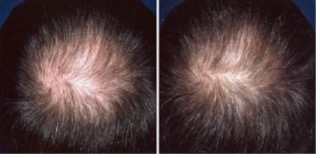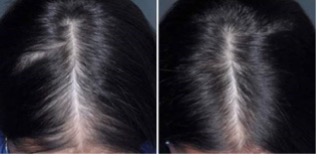Science behind Minoxidil for Hair Growth
The mechanism by which minoxidil stimulates hair growth is not fully understood, but minoxidil can reverse the hair loss process of androgenic alopecia by the following means28:
1. Reversing follicle miniaturisation
2. Increasing blood flow to the follicle
3. Stimulating follicles from the resting phase to the growing phase
4. Increasing the length of time of the growing phase
The active ingredient in Regaine is minoxidil, the only over-the-counter active ingredient clinically proven to help stop and even reverse hereditary hair loss4. If you are still in an early or light stage of hair loss, REGAINE® offers you better results by stabilize hair loss and stimulate its regrowth. It works by increasing the blood flow to the hair follicles and increasing follicular size and hair shaft diameter, stimulating and prolonging hair growth.4,28
Find out more about how minoxidil works
Clinical Trials of REGAINE® Products for Men & Women


In a clinical trial of 352 men aged between 18 and 49, more than 9 of 10 men were satisfied with dosage form and ease of use of minoxidil 5% foam at week 2436 REGAINE® for Men Foam can increase hair growth by 4 times as much as placebo.5


REGAINE® IS CLINICALLY PROVEN TO REGROW HAIR4
REGAINE® contains minoxidil the only over-the-counter active ingredient clinically proven to help stop and even reverse hereditary hair loss.4

NOTICE THINNING HAIR?In hereditary hair loss, a combination of genetics, hormones, and age causes progressive shrinking of hair follicles, shortening your hair’s growth cycle.20
HELPS TREAT HEREDITARY HAIR LOSSLeft untreated, each growth cycle produces shorter, finer, hairs until growth ceases, so start using Regaine® as soon as you notice thinning hair.
USE REGAINE TO HELP REGROW HAIRRegaine® helps restore inactive hair follicles to lengthen your hair’s active growth phase.4,28
FOR BEST RESULTS STICK WITH ITWithin 3-6 months of using Regaine®, you may begin to see visible results.2,3,5 With continued use, you may enjoy improved coverage with thicker, fuller hair.
WHAT HAPPENS IF YOU STOP?If you stop using REGAINE®, your normal hair loss process will start again, and you’ll probably lose your newly regrown hair within 3-6 months.2,3
SCIENTIFICALLY PROVEN RESULTS
Ready To Try REGAINE® Hair Loss Treatment?
References:
2. REGAINE® Solution 5% leaflet.
3. REGAINE® Solution 2% leaflet.
4. REGAINE® SPC – Section 5.1.
5. Olsen, E. A., Whiting, D., Bergfeld, W., Miller, J., Hordinsky, M., Wanser, R., Zhang, P., & Kohut, B. (2007). A multicenter, randomized, placebo-controlled, double-blind clinical trial of a novel formulation of 5% minoxidil topical foam versus placebo in the treatment of androgenetic alopecia in men. Journal of the American Academy of Dermatology, 57(5), 767–774.
20. American Hair Loss Association. (n.d.). Women’s Hair Loss: Causes of Hair Loss. Retrieved May 7, 2020, from https://www.americanhairloss.org/women_hair_loss/causes_of_hair_loss.html.
28. Messenger, A. G., & Rundegren, J. (2004). Minoxidil: mechanisms of action on hair growth. The British journal of dermatology, 150(2), 186–194.
36. Hasanzadeh, H. et al (2016). Efficacy and safety of 5% minoxidil topical foam in male pattern hair loss treatment and patient satisfaction. Acta dermatovenerologica Alpina, Pannonica, et Adriatica, 25(3), 41–44. https://doi.org/10.15570/actaapa.2016.12

